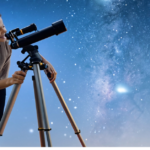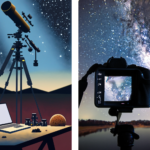Table of Contents
As soon as I began doing astrophotography, I noticed a problem. My shots were affected by too much light coming from the streetlamps, and on closer inspection, I also noticed how it affected my deep-sky astrophotography. In the first months, my photographs were limited to very short exposures because when I took shots longer than 15 or 20 seconds, the light pollution in the sky was noticeable.
Light pollution is a huge problem for us astrophotographers! But what is light pollution and why is it a problem?
Light pollution is the excessive use of artificial light, which has adverse effects on both natural and human environments. Astrophotographers and astronomers use light pollution filters when viewing and photographing the night sky, depending on the amount of light present.

This phenomenon is caused by poorly designed lighting fixtures, which emit too much light. This light is often scattered in the atmosphere, making it difficult to see the stars in the night sky.
The negative effects of light pollution are not limited to wildlife either; it also impacts humans’ sleep schedules and increases their risk for obesity, diabetes, depression, and cardiovascular disease.
Astrophotography is best carried out in dark skies with less light pollution; however, many of us who live in cities can only dream of a truly dark sky. Fortunately, there are ways to reduce the negative effects of this excess light, both during and after taking photographs of the night sky. Click on this for my tips for improving your astrophotography – this is really going to help keep you focused.
What is Light Pollution?
So what is light pollution caused by?
Light pollution is caused by the use of artificial light. It is a growing problem in many parts of the world, especially in urban areas.
Light pollution wastes an estimated $6 billion each year in the US. See more here from DarkSky.org about the effects and costs of light pollution.
The term “light pollution” was coined by Dr. Paul Bogard in his book The End of Night: Searching for Natural Darkness in an Age of Artificial Light. He defines it as “the introduction by humans, directly or indirectly, of artificial light into the natural environment.”
Light pollution can have adverse effects on both humans and wildlife. Negative light pollution examples include the effect on human health and disruption to ecosystems such as migratory birds and sea turtles that rely on natural light to navigate at night.
What are the Causes of Light Pollution?
Light pollution is the excessive use of artificial light in a way that disrupts the natural day-night cycle. It is a growing environmental problem that has been affecting both humans and wildlife.
It is clear what causes light pollution, and it has to stop!
The most common sources of light pollution are streetlights, car headlights, security lights, and commercial lighting. But there are also many other sources, such as advertising billboards, outdoor lights from malls or buildings, and even some decorative lighting.
How Does Light Pollution Affect Astronomy?

What is light pollution doing to our view of the night sky?
Light pollution is a form of environmental pollution, and it is the reason why we can no longer see the stars at night. Artificial light pollution prevents us from seeing the stars.
In the photo above, we can clearly see how light pollution affects the whole picture and removes the details.
There are different types of light pollution, including skyglow, glare, and light trespass. Skyglow occurs when there are too many lights in an area that don’t have any kind of shielding or dimming features. Glare happens when there are too many lights in an area that cause a reflection on the surface below it. Light trespass happens when there are too many lights in an area that shine into people’s homes or yards and disrupt their normal sleeping patterns.
The effects of light pollution on astronomy vary depending on what kind of astronomical research you’re doing. Astronomers who study planets may be less affected, but those who photograph deep-sky objects as I do will need to find ways to escape or reduce light pollution.
The Problems I’ve Experienced with Light Pollution in Astrophotography
What is light pollution doing to our astrophotos?
I’d like to show you some examples of the struggle I’ve had coping with light pollution in my astrophotography. Despite the skies I regularly image under Bortle 5, a rural sky, it still has an effect, especially on longer exposures.
Here is an image composed of stacked photos. Notice how much light pollution washes out the nebula.

The above image was composed of stacked photographs taken in a Bortle 5 sky! The light pollution almost totally obscures the image of the North American Nebula.
By the way, the measurement of how dark a sky is is done by referencing the Bortle scale, where Bortle 10 is the worst and Bortle 1 is the best and darkest sky. Most cities are Bortle 8 or more, and there you’ll only see a few stars. In my location at Bortle 5, I can see hundreds of stars, and when I travel to a better location, Bortle 4, I can then see thousands of stars!
My view of the northern sky is much darker than the west or south. It is very common that in certain parts of the sky you have, there may be variations where the actual level of light pollution is more or less than the average.
What are the Solutions to Reduce Light Pollution?
The solutions to reducing light pollution are mainly the responsibility of the government. The government regulates the use of lights and has policies on how they are used.
It is not just the government that is to blame for increasing light pollution. We are also responsible. There are also solutions that people can implement themselves. The most important is to increase awareness in others of the importance of reducing light pollution.
Another solution is to use motion sensor lights, which turn off when there is no motion detected. Another way is to install a shield on your windows so that it blocks out light from outside sources.
In astrophotography, we can use light pollution filters. These filters help because they only allow certain frequencies of light to pass and therefore block the light from artificial sources such as streetlamps or city lights.
Most artificial outdoor lights emit light as very specific frequencies so light pollution filters seek to block these frequencies. It is important that these filters do not block out frequencies of light that are present in astronomical objects. These filters cannot block out all light pollution.
The use of filters to block out light pollution can make the background appear darker and increases contrast in the image so it does help but this solution does not allow us to see more detail in the object we photograph. The only real solution that will do that is to seek darker skies.
Light pollution filters are absolutely necessary if you live under urban skies and will improve the look of your images many times over, so do use them.
Recently, I began imaging using a clip-in HA filter to block out light pollution, especially from the full moon. The moon is a regular source of excessive light that makes it difficult to photograph nebulae or galaxies at certain points in the moon cycle.
As my skills have improved, I am able to lessen the effects of light pollution in the post-processing of my images in Photoshop. In some cases, it can almost completely be removed, but a dark sky is always best for the highest-quality images.
Let me give you a few techniques I use to counteract the effects of light pollution. The first is to take more images to increase the signal and reduce noise but as light pollution also increase I need to use use background extraction (I use Siril for this). This darkens the background in my image and does not touch the light in the object I am photographing.
I use the levels control to darken the background especially after stretching my image to bring out the details. Another tool I can use is Gradient removal using plugin for Photoshop. I make sure to only apply this to areas around my target in my image.
Finally, a small amount of dehaze using the camera raw filter in Photoshop also helps to reduce the effects of light pollution.
Also, when imaging, there are ways to use software to check the exposure level and the level of light pollution in your images. The use of a laptop in astrophotography is something I cover in detail here; be sure to check out my advice.
The Importance of Dark Skies for Astrophotography
Many claim that dark skies are the most important thing of all in astrophotography. But why is it so important to astrophotographers?
Here are some of the reasons why a dark sky is so important for astrophotography:
- You will be able to see and photgraph fainter objects more easily
- A darker sky will mean that you can obtain the same results in your image with less exposure time.
- Compared to a city location, it could take up to 40 times less to get the same quality image at a dark site!
The Importance of Reducing Light Pollution for a Brighter Future
What is light pollution doing to the environment?
Light pollution is a growing global problem, and it has adverse effects on both humans and wildlife. How?
Both animals and humans have used the natural cycle of the day and it’s periods of light and darkness to function properly. For example, sleep requires darkness and the light disturbs the quality of our rest during the night. Sleep is vital for our good health.
Too much artificial light can disturb nocturnal animals by changing night into dusk or even daytime conditions. Light pollution is now so bad that near cities the sky may be hundreds or thousands of times brighter than normal and this is very harmful to many species of animals.
We should reduce light pollution to make the world a brighter place for future generations and to avoid negative effects on both humans and wildlife.
An important step would be to take action by reducing the amount of light that we use at night. This can be done by using LED lights or turning off lights when they are not needed. More energy-efficient lighting systems would also help.
We should pressure our communities to reduce the amount of light pollution around us. But there are steps we can take to reduce overall light pollution. These include:
- Closing curtains and drapes to reduce light leaving our homes or to reduce the amount of light entering from outside.
- Don’t drive at night. This will reduce your contribution to light pollution.
- Use fewer lights in your garden and turn them off when you don’t need them.
- Use only lights that point light downwards at the ground. There are too many lights that send unnecessary light into the sky rather than at the road or path.
Light pollution can also increase the risk of breast cancer in women who work night shifts or are exposed to high levels of artificial light at night during their leisure time. Here is a link to a study into the connection between artificial light at night and cancer. This study included data from 158 countries and concluded there was strong link between cancer and artificial light at night.








